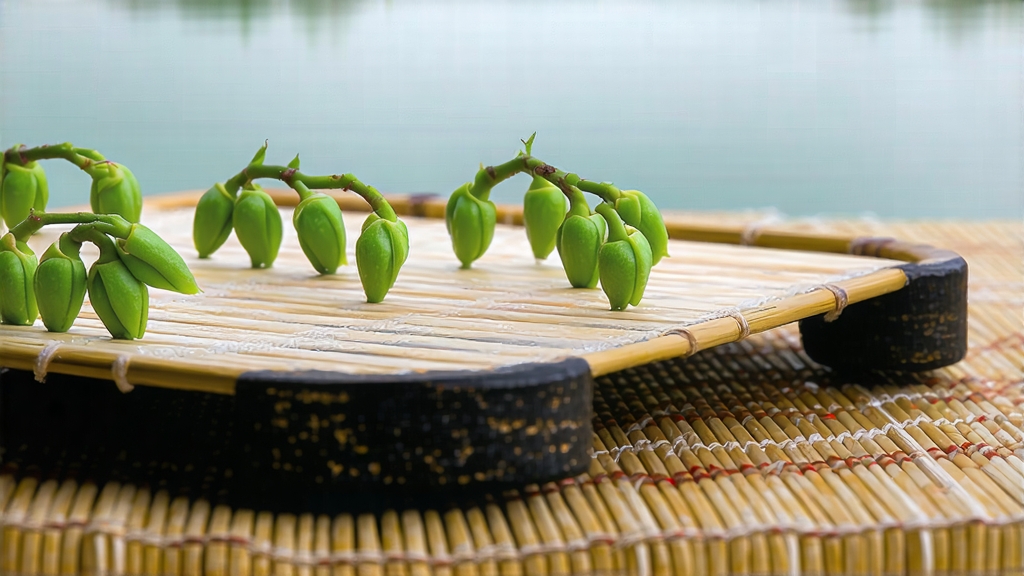
Among the jade-colored constellation of Chinese green teas, none carries the romance of lake mist and imperial whim quite like Biluochun. Born on the islands and hills that rise from Taihu Lake in Jiangsu Province, its name translates literally to “Green Snail Spring,” a poetic compression of three truths: the tea’s jade spiral shape, its early-spring plucking, and the tiny, snail-like curl that survives all the way to the cup. Foreign drinkers often meet it under the older romanization “Pi Lo Chun,” yet whatever the spelling, the leaf whispers the same story of dynastic chance, horticultural serendipity, and craftsmanship measured in seconds.
History: From Island Briar to Tribute Tea
Local chronicles credit the tea’s discovery to tea-picking girls of Dongting Mountain in 1675. While foraging for wild tea amid peach, plum, and apricot thickets, they tucked fragrant buds into their apron pockets; the warmth of their bodies lightly oxidized the leaf, releasing an aroma so arresting that villagers rushed to replicate the scent. Word traveled up the Grand Canal to the Kangxi Emperor, who tasted the brew in 1699 and, smitten by the “frighteningly fragrant” (xia sha ren xiang) infusion, decreed it an annual tribute. The court renamed the tea “Biluochun” to honor both its form and season; previously it had been sold under the homely moniker “Xia Sha Ren Xiang,” literally “scary fragrance.” Thus a humble briar leaf became one of China’s ten most famous teas, its acreage expanding from a few mu of island scrub to the terraced slopes of Dongting East and West Mountains today.
Micro-Terroir: Lake, Mist, and Fruit Trees
Taihu’s vast surface acts as a thermal mirror, reflecting spring sunlight back onto low hills while storing daytime heat that it slowly releases at night. The result is a diurnal swing of 8–10 °C, perfect for building amino acids—especially L-theanine—while keeping tannins in check. More unusually, farmers interplant tea bushes with fruit trees: peach, plum, apricot, loquat, and pomegranate. When March blossoms open, their pollen drifts onto the nascent buds, imprinting a nectarous note that connoisseurs describe as “flower-fruit rhyme.” No other Chinese green tea enjoys such deliberate horticultural companionship; it is terroir engineered by scent.
Plucking Standards: One Bud with Its Just-Opened Leaf
Official national standards (GB/T 18957-2008) recognize six grades of Biluochun, but all share the same plucking protocol: one bud and the immediately adjacent leaf, no longer than 2.5 cm, picked before the Qingming festival (around April 5). Experienced pickers work barefoot on 45° slopes, dropping leaf into bamboo baskets lined with thin cotton to prevent bruising. A full day’s haul for a top-grade lot weighs barely 500 g fresh—about 9,000 tips—which will shrink to 100 g after firing. Such parsimony explains why supreme-grade Biluochun can command over US $1,000 per 500 g at pre-Qingming auction.
Craft: The 15-Minute Tightrope
Within four hours of plucking, the leaf must be “sha qing” (kill-green) to halt oxidative enzymes. Craftsmen use a duck-egg-green wok heated to 180 °C, tossing 250 g of leaf in rhythmic arcs. After 3–4 minutes, when leaf temperature reaches 70 °C, they drop the fire to 80 °C and begin the “cuo tuan” (rub-and-roll) phase. Using feather-light pressure, they roll the leaf against the wok wall in a counter-clockwise spiral, coaxing the bud to curl like a snail while rupturing just 12–15 % of cell walls—enough to release sap that caramelizes into sweetness, not enough to liberate harsh catechins. The entire cycle—withering, sha qing, cuo tuan, and final drying—lasts barely 15 minutes. A five-second lapse can scorch the tips or leave them grassy; hence the saying “Biluochun is made, not picked.”
Grading: Downy Silver vs. Jade Green
Top-grade Biluochun displays silver-white down evenly distributed over a jade-green curl; when dropped into a glass, the leaf sinks